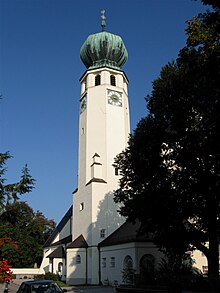St. Canisius (Großhadern)
St. Canisius is a Catholic parish church in the Munich district of Großhadern . The patron saint of the church is the German Jesuit Father Petrus Canisius , who was born on May 21, 1925 in Rome by Pope Pius XI. has been canonized.
history
In 1924 the church administration decided to build a new church in Hadern and commissioned the Munich architect Franz Rank to plan a “simply furnished, spacious” church. In his eclectic design , Rank integrates Gothic and Baroque styles . The building is a single-aisled hall with a Gothic-style pointed arch vault, baroque wall structure and a two-story organ gallery on the west side. The furniture of the church, such as the main and side altars, the pulpit and the organ prospect, are based on the Baroque forms.
The foundation stone was laid on July 5, 1925, and the topping-out ceremony was held on November 3 . Due to financial problems u. a. of the originally planned altar only the altarpiece will be realized and the church received a simpler interior than planned. On August 29, 1926 the church was consecrated by Cardinal Faulhaber .
The church was hit by incendiary bombs during World War II , but the fires were quickly extinguished. In 1947 St. Canisius was renovated. The lower church, which was originally planned as a weekday chapel, was u. a. Used as a library, group room for young people and adults, for rehearsals by the church choir and occasional lectures.
Around 1990 the top of the tower, which was slightly damaged during the air raids in World War II, caused water to seep in, which caused the oak substructure to rot. The spire in the form of a baroque onion hood was replaced and a new weathercock, a gold-plated cross and new sheet metal were installed. In 2009 the entire roof of the St. Canisius Church was renovated.
organ
The organ was built in 1983 by the organ builder Josef Garhammer (Weilheim). The slider chest instrument has 38 registers (approx. 2400 pipes) on three manuals and a pedal. The playing and stop actions are mechanical.
|
|
|
|
||||||||||||||||||||||||||||||||||||||||||||||||||||||||||||||||||||||||||||||||||||||||||||||
- Coupling : I / II, I / P, II / P,
Individual evidence
Web links
Coordinates: 48 ° 6 ′ 48.2 " N , 11 ° 28 ′ 53.4" E



